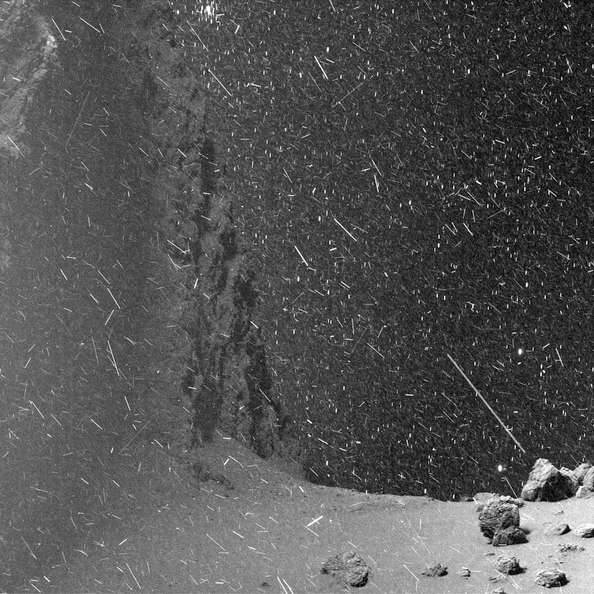The European Space Agency’s Rosetta mission was an ambitious one. As the first-ever space probe to rendezvous with and then orbit a comet, Rosetta and its lander (Philae) revealed a great deal about the comet 67p/Churyumov-Gerasimenko. In addition to the learning things about the comet’s shape, composition and tail, the mission also captured some incredible images of the comet’s surface before it ended.
For instance, Rosetta took a series of images on June 1st, 2016, that showed what looks like a blizzard on the comet’s surface. Using these raw images (which were posted on March 22nd, 2018), twitter user landru79 created an eye-popping video that shows just what it would be like to stand on the comet’s surface. As you can see, its like standing in a blizzard on Earth, though scientists have indicated that it’s a little more complicated than that.
The video, which consists of 25 minutes worth of images taken by Rosetta’s Optical, Spectroscopic, and Infrared Remote Imaging System (OSIRIS), was posted by landru79 on April 23rd, 2018. It shows the surface of 67p/Churyumov-Gerasimenko on the loop, which lends it the appearance of panning across the surface in the middle of a snowstorm.
#ROSETTA ? OSIRIS #67P/CHURYUMOV-GERASIMENKO new albums ?–ROSETTA EXTENSION 2 MTP030– Miércoles 1 Junio 2016 all filters stacked pic.twitter.com/Bf173Z5g79
— landru79 (@landru79) April 23, 2018
However, according to the ESA, the effect is likely caused by three separate phenomena. For instance, the snow-like particles seen in the video are theorized to be a combination of dust from the comet itself as well as high-energy particles striking the camera. Because of OSIRIS’ charge-coupled device (CCD) – a radiation-sensing camera – even invisible particles appear like bright streaks when passing in front of it.
As for the white specks in the background, those are stars belonging to the Canis Major constellation (according to ESA senior advisor Mark McCaughrean). Since originally posting the video, landru79 has posted another GIF on Twitter (see below) that freezes the starfield in place. This makes it clearer that the comet is moving, but the stars are remaining still (at least, relative to the camera’s point of view).
And of course, the entire video has been sped up considerably for dramatic effect. According to a follow-up tweet posted by landru79, the first image was shot on June 1st, 2016 at 3.981 seconds past 17:00 (UTC) while the last one was shot at 170.17 seconds past 17:25.
Si apilamos todo el set alineando con las estrellas de fondo se distingue mejor que son estrellas y q es polvo (olvidaos de rayos cósmicos ) #ROSETTA ? OSIRIS #67P/CHURYUMOV-GERASIMENKO new albums ?–ROSETTA EXTENSION 2 MTP030– Miércoles 1 Junio 2016 all filters stacked? pic.twitter.com/UyZ628JxKP
— landru79 (@landru79) April 24, 2018
Still, one cannot deny that it is both captivating and draws attention to what Rosetta the mission accomplished. The mission launched in 2004 and reached 67P/Churyumov-Gerasimenko in 2014. After two years of gathering data, it was deliberately crashed on its surface in 2016. And yet, years later, what it revealed is still captivating people all over the world.
Further Reading: Live Science, Gizmodo


That is so beautiful but a little giddying when you focus on the stars.